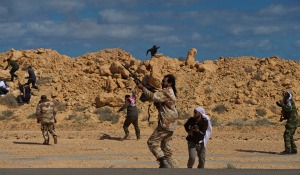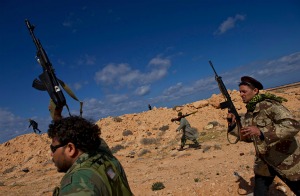On the Front Line
Addario spent the next 13 days on the front line, following the rebels as they battled government troops for control of the territory between Benghazi and Tripoli. She was one of a group of 10-20 journalists, mostly photographers, who covered the conflict firsthand. They were a tight group, veterans of the wars in Afghanistan and Iraq, and Addario knew most of them well. They were operating under dangerous conditions, with none of the support that journalists often receive in high-profile conflict zonesno guards, no translators, no armored cars, no hotel security, no professional intelligence reports. They kept tabs on each other and shared everythingvehicles, drivers, camera lenses, memory cards, food, housing, information. Most importantly, they shared what Addario calls the same level of fear. She amplifies:
When youre covering combat you want to be with people who have some experience, who are not going to want to run away the second the fighting starts, because vehicles and drivers are limited and you dont have that much mobility. You need to be with people you trust, who have good judgment, and who are more or less on a par with the level of risk you want to take.
For the first two days, Addario saw little fighting. Hicks went briefly to the front, but Addario stayed behind the lines covering hospital casualties and a funeral. Rebel sympathizers in Brega gave them food and lodging. On March 4 she joined the rebel soldiers, filing a photo of a rag-tag group firing an anti-aircraft gun in a desert wasteland.
Addario had traveled with combat troops before, embedded with US forces in Iraq and Afghanistan, but those were disciplined, professional soldiers. These rebel troops were not; they were mostly untrained citizen volunteers: doctors, engineers, students, a mishmash of people, Addario says. They were glad to have the journalists with them as observers, and they treated Addario as an equal, apparently comfortable with her presence as a woman on the front line. Their acceptance allowed her to relax her usual rules about covering up in Muslim countries. I dressed in long shirts but I wasnt covering my hair, Addario recalls.
It was clear to me that the rebels didnt care whether or not I had hijab on, so I decided not to wear it because it is a pain when youre getting shot at, to constantly be adjusting your headscarf.
By March 5, Addario was under fire much of the time, as rebels battled Qaddafi troops for control of a major oil refinery at Ras Lanuf. This was not like Iraq and Afghanistan, where she could choose whether to go on patrol or stay back. The fighting became fierce and went on for four and five hours at a time. Qaddafis forces were throwing everything they had at the rebels: attack helicopters, Grad rockets, machine gun fire, bombs, mortars and other artillery; the rebels had their own rocket-propelled grenades, machine guns, and Kalashnikov rifles. After one engagement, Hicks told the Times that he had never seen so much firepower in one day in all his years of reporting. [28]
As the fighting intensified, it became hard to get vehicles and drivers, harder still to keep them on the front line. Local bilingual drivers were critical assets, especially for those who, like Addario and Hicks, did not speak Arabic. They were the journalists eyes and ears, relaying the soldiers shouted exchanges as well as chatter from behind the lines, which they received in a constant stream from friends and relatives on their cellphones. They were also literally the journalists means of escape. The drivers were committed insurgents, but they were young and untrained and scared, and not always reliable under fire.


Scenes of panic from the front lines
Photos by Lynsey Addario
On March 6, outside the city of Bin Jawwad, Addario had a moment of panic. Under attack from helicopter gunships and artillery fire, she became separated both from her driver and from her colleagues. As she surveyed the surrounding terrain, she realized there was no place to hide. There were bullets just flying above my head nonstop, she recalls. I looked up and I said, I have to get out of here. I have to get out of here. She made it to the car of other photographers, and they escaped back to Ras Lanuf. [29] Her pictures from that day showed panic and disarray . On March 10, Addario told an interviewer that that the Libya conflict was the most dangerous she had ever covered. [30]
Hear more: Lynsey Addario recalls escaping heavy fire in Bin Jawwad
[28] MacDonald and Furst, In the Thick of Libyas Brutal Fighting.
[29] Another journalist, Jean-Marie Lemaire, a French photographer working for the news station France 24, was shot in the calf during this same engagement; his cameras were also hit. Colleagues had earlier tried to persuade him to leave the front in the packed car Addario had run to, but he had refused. Lemaire survived. Overview of Recent Media Freedom Violations, International Freedom of Expression Exchange Alert, March 8, 2011. See: http://www.ifex.org/middle_east_north_africa/2011/03/08/media_freedom_violations/
[30] Lynsey Addario, The Most Dangerous Thing Ive Ever Covered, The Daily Beast, Beast TV, March 10, 2011. See: http://www.thedailybeast.com/newsweek/videos/2011/03/16/nytimes-photographer-lynsey-addario-reporting-from-libya.html